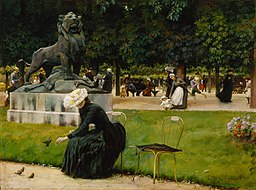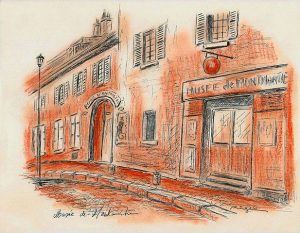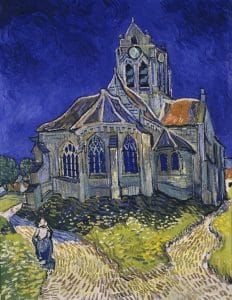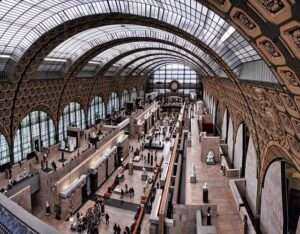Paris Impressionism : Let’s discover the greatest impressionist artists from the 19th century to the beginning of the 20th century. Those painters have sublimated Paris.
Paris Impressionism Private Tours
PARIS BY EMY offers custom Paris private tours designed to give you an in-depth look at the Impressionist movement in Paris, with a focus on the key locations, stories, and artworks that tell the tale of this revolutionary period in art history. Our private tours include:
- Adjusting the tour length to fit your schedule
- Adding stops at art galleries or cafés frequented by the Impressionists
- Exploring specific works or artists in more detail, based on your preferences
- Including a stop at Giverny day trip from Paris and garden, for a full-day excursion
What is Impressionism ?
Impressionism is a pictorial movement born from the association of artists from the second half of the 19th century living in France. Strongly criticized at its inception, this movement manifested itself in particular from 1874 to 1886 through public exhibitions in Paris, and marked the break with academic painting.
This pictorial movement is mainly characterized by small format paintings, visible brushstrokes, open composition, the use of unusual viewing angles, a tendency to note fleeting impressions, the mobility of climatic and luminous phenomena, rather than the stable and conceptual aspect of things, and to transfer them directly to the canvas.

Charles Courtney Curran: In the Luxembourg (Garden)
Paris Impressionism and its painters
Painters were passionate about the city life : boulevards, streets and bridges, public gardens, halls and markets, department stores and windows, cafes, theaters and circuses, races, balls and social events …There are lots of artists to have represented Paris, the City of Lights and its inhabitants :
- Gustave Caillebotte (1848-1894) – Organized Impressionist exhibitions of 1877-79, 1880-82
- Edouard Léon Cortès (1882-1969) – He spent his life painting the streets of the capital
- Fantin-Latour (1836-1904) – He is a realistic and intimate painter, and French lithographer
- Paul Gauguin (1848-1903) – French Post-Impressionist artist unappreciated until after his death
- Albert Lebourg (1849-1928) – Loved painting Paris and especially Notre Dame
- Claude Monet (1840-1926) – Founder of French Impressionism and most consistent
- Edouard Manet (1832-1883) – He is a pivotal figure in the transition Realism to Impressionism
- Camille Pissarro (1830-1903) – Danish-French Impressionist and Neo-Impressionist painter
- Auguste Renoir (1841-1919) – French artist leading painter of Impressionism
- Toulouse-Lautrec (1864-1901) – French painter, printmaker, and illustrator for the Moulin Rouge
- Vincent Van Gogh (1853-1890) – Dutch post-impressionist painter posthumously famous
- Berthe Morisot (1841-1895) – Morisot exhibited in the esteemed Salon de Paris
- Suzanne Valadon (1865-1938) – First woman admitted to Société Nationale des Beaux-Arts
Impressionism mouvement in France
Paris Impressionism and its museums
Orsay Museum the greatest of Paris Impressionism
Orsay Museum is THE museum to visit if you are a fan of Paris Impressionism and its major painters. The story of the museum’s building is unusual. Located in the heart of Paris, along the Seine, facing the Tuileries Garden not too fear from the Louvre by walk, the museum is located in the former Orsay station, a building built for the Universal Exhibition of 1900.
The Musée d’Orsay is a must-visit for anyone interested in Impressionism. This museum has an extensive collection of Impressionist and Post-Impressionist works. During the tour, you’ll view Monet’s Water Lilies, Renoir’s Dance at Le Moulin de la Galette, and Degas’s Ballet Rehearsal, gaining insights into the techniques and inspirations behind each piece. The Musée d’Orsay is a national museum open to the public on December 9, 1986 to show, in all its diversity, the artistic creation of the Western world from 1848 to 1914. It was made up of national collections coming mainly from 3 Parisian museums including the Louvre.
- the Louvre museum for the works from 1820, or the art world with the Second Republic
- the Jeu de Paume museum dedicated since 1947 to Impressionism
- the National Museum of Modern Art which only kept the works of artists born after 1870
Its collections present Western art from 1848 to 1914, in all its diversity: painting, sculpture, decorative arts, graphic art, photography, architecture, etc. It is one of the largest museums in Europe for this period. While the Louvre is known for its classical art, it’s also essential for understanding the context in which Impressionism developed. This part of the tour highlights key works that influenced the Impressionists, offers a perspective on how their innovative techniques emerged.
Montmartre Museum home of Paris Impressionism
No Impressionism tour would be complete without a stroll through Montmartre private tour. This historic hilltop neighborhood was a bustling hub for artists and bohemians in the late 19th century. With its cobblestone streets and iconic landmarks, Montmartre provides a glimpse into the world that inspired the Impressionists. Key locations in Montmartre include:
- Place du Tertre: Where artists gather to paint and sell their work.
- Moulin de la Galette: Immortalized in Renoir’s painting of the same name.
- Café des Deux Moulins: A classic Parisian café where you can relax and soak in the atmosphere
The Musée de Montmartre – Jardins Renoir is a French art museum located in Paris, in the 18th arrondissement. Inaugurated in 1960, it was reorganized from 2011 and gives several annual temporary exhibitions. A few steps from the Sacré-Coeur, the Montmartre museum and its gardens offer a haven of peace and greenery.

Discover Suzanne Valadon’s workshop at The Musée de Montmartre. After living there until 1905 with her first husband, the banker Paul Moussis, Suzanne Valadon returned to the rue Cortot studio in 1912 and settled there with her son Maurice Utrillo and her companion, André Utter. Despite arguments with André Utter and escapades of her son, Suzanne Valadon spent the most productive years of her life there. The Musée de Montmartre gardens are inspired by masterpieces painted on site by Auguste Renoir. Discover about the history of Impressionism.
Marmottan Monet Museum
With over one hundred masterpieces on display, the exhibition showcases an ensemble of works ranging from the 15th to the 21st century, including Dürer, Rembrandt, Piranesi, Goya, Corot, Manet, Degas, Bonnard, Vuillard… The Museum houses the world’s biggest collection of works by Monet. Alongside the iconic Impression, Sunrise, some hundred masterpieces bequeathed by the painter’s family and close friends offer an unmatched panorama of the art of the leading Impressionist. Come and let Monet’s secret garden work its charm!
For a deeper dive into Monet’s work, PARIS BY EMY also offers the option to visit the Musée Marmottan Monet. This museum houses the largest collection of Monet’s works, including his famed painting Impression, Sunrise, which gave the Impressionist movement its name. You’ll gain a deeper understanding of how Monet’s work evolved over the years, and his lasting influence on the world of art.
L’Orangerie Museum
The Jean Walter and Paul Guillaume collection is one of the most wonderful European collections of paintings. Indeed, it is bringing together 148 works from the 1860s to the 1930s. When the French state bought the collection at the end of the 1950s, the collection was then displayed in the Musée de l’Orangerie. Today, its impressionist works are made up of 25 paintings by Renoir, 15 by Cézanne, 1 by Gauguin, 1 by Monet and 1 by Sisley.
Regarding the twentieth century, the museum is proud to present 12 works by Picasso, 10 by Matisse, 5 by Modigliani, 7 by Marie Laurencin, 9 by Henri Rousseau, 31 by Derain, 10 by Utrillo, 22 by Soutine, and 1 by Van Dongen.
This museum offers an intimate look at Monet’s work, displayed in two large, oval rooms designed to immerse viewers in the tranquil beauty of his garden in Giverny. PARIS BY EMY ensures you get a personalized exploration of this masterpiece, with rich insights into Monet’s creative process.
Impressionism and Giverny
Giverny is a lovely village in Normandy with at least one hour drive from Paris. French impressionist painter Claude Monet lived in his home at Giverny for 43 years, from 1883 to his death in 1926. The artist’s former home and elaborate gardens, where he produced his famed water lily series, are now the Fondation Claude Monet museum. Nearby, the Musée des impressionnismes Giverny highlights the Impressionist art movement.

Impressionism and Auvers-sur-Oise
Auvers-sur-Oise is a little town on the northwestern outskirts of Paris, France. It is located 27.2 km (16.9 mi) from Paris. On May 20, 1890, Vincent van Gogh took a pension for 3.50 francs a day at the Auberge Ravoux in Auvers-sur-Oise. He lives in a modest 7m2 attic, bedroom No.5, lit by a simple skylight. On July 28 and 29, 1890, Theo van Gogh attended the last moments of his brother Vincent. By superstition, “the suicide room”, an essential part of the painter’s sensitive universe, has never been rented again.

Church in Auvers-sur-Oise by Van Gogh
The famous painter indeed spent the last weeks of his life in this small village of Val-d’Oise. Vincent van Gogh only spent 70 days in Auvers-sur-Oise. This short stay was nevertheless extraordinarily prolific, since this site inspired more than 70 works.
Beyond Paris Impressionism Private Tour
We focus on creating custom-made Paris Tour Package experiences based on your interests.
PARIS BY EMY offers customizable Paris private tour guide as well to focus on what to do in Paris or leisure activities to do in Paris, tailoring the experience to your interests.


